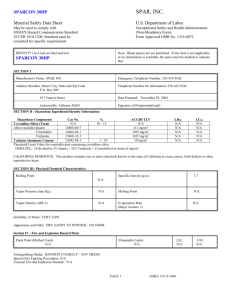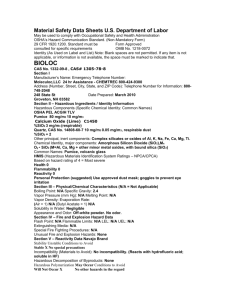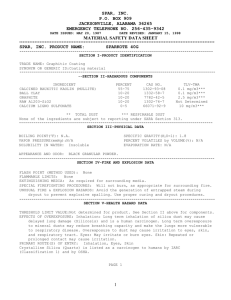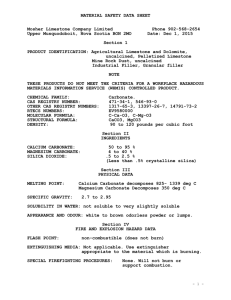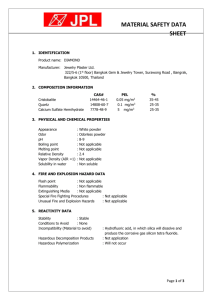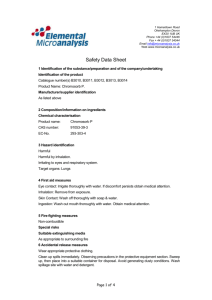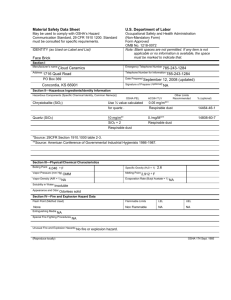FLY ASH / ASTM Class C
advertisement
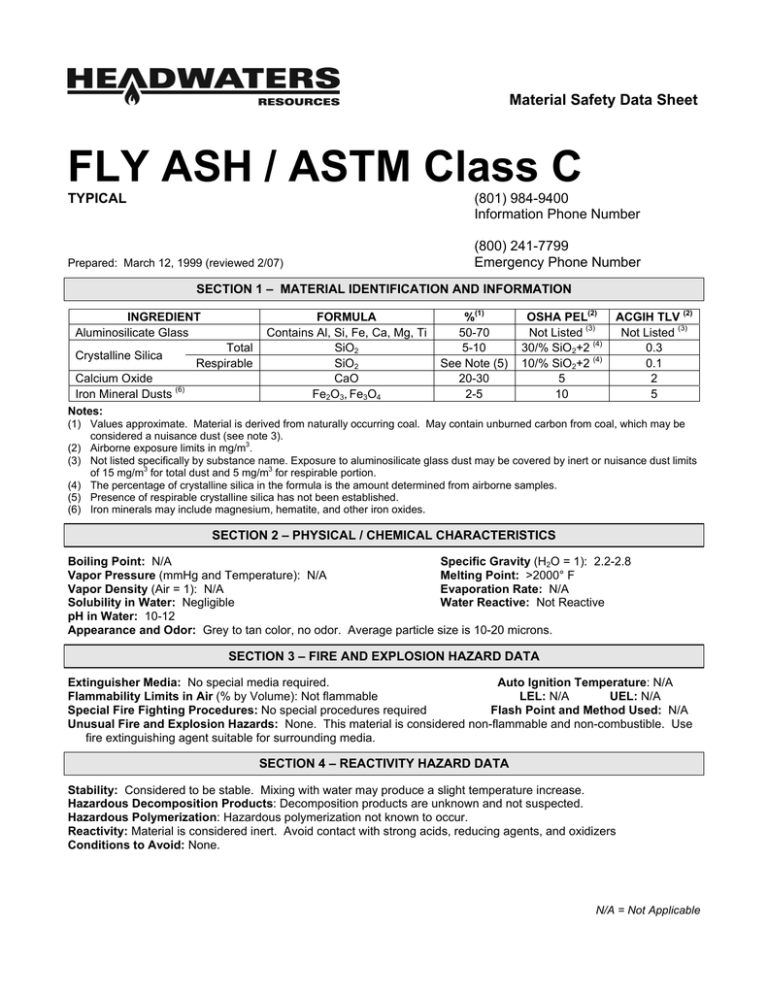
Material Safety Data Sheet FLY ASH / ASTM Class C TYPICAL (801) 984-9400 Information Phone Number Prepared: March 12, 1999 (reviewed 2/07) (800) 241-7799 Emergency Phone Number SECTION 1 – MATERIAL IDENTIFICATION AND INFORMATION INGREDIENT Aluminosilicate Glass Crystalline Silica Calcium Oxide Iron Mineral Dusts (6) Total Respirable FORMULA Contains Al, Si, Fe, Ca, Mg, Ti SiO2 SiO2 CaO Fe2O3, Fe3O4 %(1) 50-70 5-10 See Note (5) 20-30 2-5 OSHA PEL(2) Not Listed (3) 30/% SiO2+2 (4) 10/% SiO2+2 (4) 5 10 ACGIH TLV (2) Not Listed (3) 0.3 0.1 2 5 Notes: (1) Values approximate. Material is derived from naturally occurring coal. May contain unburned carbon from coal, which may be considered a nuisance dust (see note 3). (2) Airborne exposure limits in mg/m3. (3) Not listed specifically by substance name. Exposure to aluminosilicate glass dust may be covered by inert or nuisance dust limits of 15 mg/m3 for total dust and 5 mg/m3 for respirable portion. (4) The percentage of crystalline silica in the formula is the amount determined from airborne samples. (5) Presence of respirable crystalline silica has not been established. (6) Iron minerals may include magnesium, hematite, and other iron oxides. SECTION 2 – PHYSICAL / CHEMICAL CHARACTERISTICS Boiling Point: N/A Specific Gravity (H2O = 1): 2.2-2.8 Vapor Pressure (mmHg and Temperature): N/A Melting Point: >2000° F Vapor Density (Air = 1): N/A Evaporation Rate: N/A Solubility in Water: Negligible Water Reactive: Not Reactive pH in Water: 10-12 Appearance and Odor: Grey to tan color, no odor. Average particle size is 10-20 microns. SECTION 3 – FIRE AND EXPLOSION HAZARD DATA Extinguisher Media: No special media required. Auto Ignition Temperature: N/A Flammability Limits in Air (% by Volume): Not flammable LEL: N/A UEL: N/A Special Fire Fighting Procedures: No special procedures required Flash Point and Method Used: N/A Unusual Fire and Explosion Hazards: None. This material is considered non-flammable and non-combustible. Use fire extinguishing agent suitable for surrounding media. SECTION 4 – REACTIVITY HAZARD DATA Stability: Considered to be stable. Mixing with water may produce a slight temperature increase. Hazardous Decomposition Products: Decomposition products are unknown and not suspected. Hazardous Polymerization: Hazardous polymerization not known to occur. Reactivity: Material is considered inert. Avoid contact with strong acids, reducing agents, and oxidizers Conditions to Avoid: None. N/A = Not Applicable SECTION 5 – HEALTH HAZARD DATA PRIMARY ROUTES OF ENTRY: Inhalation: Can irritate respiratory tract; long-term exposure to respirable silica above the OEL may produce silicosis in susceptible persons. Ingestion: Possible, but very unlikely to occur in sufficient quantities. Skin and Eye Contact: Can dry and irritate the skin; is not absorbed by skin. Can irritate eyes. Hazardous: Is not considered hazardous. CARCINOGEN LISTED IN: NTP: Yes (Crystalline Silica)* IARC Monograph: Yes (Crystalline Silica)* OSHA: No * Coal fly ash is not a listed carcinogen. Respirable crystalline silica from occupational sources is listed as carcinogenic to humans (Group1) by IARC. NTP lists silica, crystalline (respirable) as a compound that may reasonably be anticipated to be a carcinogen. Presence of crystalline silica in respirable dust has not been established in this source. HEALTH HAZARDS: Acute: Fly ash may cause irritation to the respiratory tract, eyes, or the skin. Alkaline material; irritation may be aggravated by the addition of moisture (sweat). Chronic: Prolonged inhalation exposure may cause pulmonary fibrosis or chronic bronchitis. Signs and Symptoms of Exposure: Irritation of eyes, skin, and respiratory system. Medical Conditions Generally Aggravated by Exposure: May aggravate existing pulmonary condition if high dust situation is created. Dusting conditions should not occur under normal use. EMERGENCY FIRST AID PROCEDURES: Eye Contact: Flush for 15 minutes with water. Seek medical care as needed to remove particles and treat scratched cornea. Skin Contact: Wash with mild soap and water. Inhalation: Remove to fresh air; seek medical attention if respiratory symptoms (coughing, chest tightness, shortness of breath) persist. Ingestion: Rinse mouth out with water. Induce vomiting if significant quantities are ingested. SECTION 6 – CONTROL AND PROTECTIVE MEASURES Respiratory Protection: If airborne dust exposure approaches the TLV or PEL (Section 1), use half-mask or full-face air purifying respirator equipped with NIOSH or MSHA-approved high efficiency filters for protection against pneumoconiosis-producing dust. An airline respirator may be required where dust levels are extremely high. Recommend use of a NIOSH or MSHA-approved mask or respirator for nuisance dusts whenever dust is created below TLV or PEL. Protective Gloves: Limit contact with skin. Use rubber or cloth gloves as necessary. Eye Protection: Wear goggles or face shield as appropriate. Avoid contact lenses. Ventilation to be Used: Keep dust levels below PEL. Use general and local exhaust ventilation and dust collection systems to keep dust levels within acceptable limits. Other Protective Clothing and Equipment: Protective clothing may be necessary under heavy dusting conditions. Hygienic Work Practices: Do not allow dust to get into eyes, to be inhaled, to be swallowed, or to remain on skin if irritation occurs. Minimize dusting. Practice good personal hygiene. Wash or shower after use. Launder clothes as normal. SECTION 7 – PRECAUTIONS FOR SAFE HANDLING / LEAK PROCEDURES Steps to be Taken If Material is Spilled or Released: Do not create unnecessary airborne dust. Avoid inhalation. Use water mist to reduce dust. Provide ventilation as appropriate. Use personal protection: respiratory, skin, and eyes. Waste Disposal Methods: Fly ash is not classified as a RCRA hazardous waste. Material can be disposed of as inert solid in a permitted landfill. Follow applicable federal, state, and local rules. Precautions to be Taken in Handling and Storage: Avoid dust inhalation. Use water and other available means to minimize dusting. Use personal protection. Follow good housekeeping and personal hygiene practices. Other Precautions and/or Special Hazards: Certain conditions (e.g. work in enclosed areas) could create overexposure to trace elements. These activities should be evaluated for compliance with applicable standards. This MSDS has been prepared in accordance with the Hazard Communication Rule 29 CFR 1910.1200. Information herein is based on data considered to be accurate as of date prepared. No warranty or representation, express or implied, is made as to the accuracy or completeness of this data and safety information. No responsibility can be assumed by vendor for any damage or injury resulting from abnormal use, failure to adhere to recommended practices, or from any hazards inherent in the nature of the product. Prepared by Headwaters Resources Corporate Office: 10653 S. River Front Parkway, Suite 300, South Jordan, UT 84095
